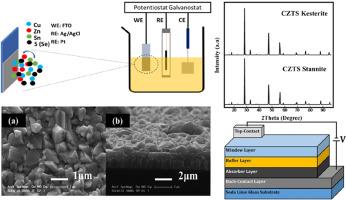Electrodeposition synthesis of Cu2ZnSnS4(CZTS) thin films as a promising material for photovoltaic cells: Fundamentals, methods, and future prospects - A comprehensive review
IF 7.1
3区 材料科学
Q1 GREEN & SUSTAINABLE SCIENCE & TECHNOLOGY
引用次数: 0
Abstract
Cu2ZnSnS4(CZTS) kesterite stands out for its high absorption coefficient and direct optical bandgap, making it a promising absorber material for thin-film photovoltaic cells, combining high efficiency and low cost. CZTSSe-based solar cells currently achieve conversion efficiencies of 15.1%. With more than 3700 publications since 1988, mainly focusing on fabricating CZTS thin films by various techniques, this study looks more specifically at the synthesis of CZTS by electrodeposition. This method recently achieved an efficiency of 8.7%. This approach stands out for its ability to deposit composite metal alloys on large surfaces with controlled thickness. The study explores the impact of synthesis parameters on the physical, chemical, and morphological properties of CZTS films and their influence on solar cell efficiency. Finally, current challenges and prospects are discussed, opening perspectives for advances in synthesizing and applying CZTS thin films for photovoltaic technologies.

Cu2ZnSnS4(CZTS) 薄膜的电沉积合成是一种很有前途的光伏电池材料:基本原理、方法和未来展望--全面综述
Cu2ZnSnS4(CZTS)沸石因其高吸收系数和直接光带隙而脱颖而出,成为一种很有前途的薄膜光伏电池吸收材料,集高效率和低成本于一身。目前,基于 CZTSSe 的太阳能电池转换效率可达 15.1%。自 1988 年以来,已有 3700 多篇论文发表,主要集中在通过各种技术制造 CZTS 薄膜,本研究更具体地探讨了通过电沉积合成 CZTS 的方法。这种方法的效率最近达到了 8.7%。这种方法能够在大面积表面沉积可控厚度的复合金属合金,因而脱颖而出。本研究探讨了合成参数对 CZTS 薄膜的物理、化学和形态特性的影响及其对太阳能电池效率的影响。最后,还讨论了当前的挑战和前景,为光伏技术中 CZTS 薄膜的合成和应用开辟了前景。
本文章由计算机程序翻译,如有差异,请以英文原文为准。
求助全文
约1分钟内获得全文
求助全文
来源期刊

Materials Today Sustainability
Multiple-
CiteScore
5.80
自引率
6.40%
发文量
174
审稿时长
32 days
期刊介绍:
Materials Today Sustainability is a multi-disciplinary journal covering all aspects of sustainability through materials science.
With a rapidly increasing population with growing demands, materials science has emerged as a critical discipline toward protecting of the environment and ensuring the long term survival of future generations.
 求助内容:
求助内容: 应助结果提醒方式:
应助结果提醒方式:


